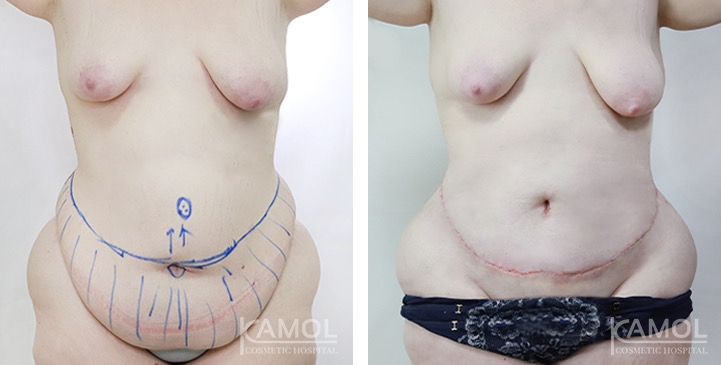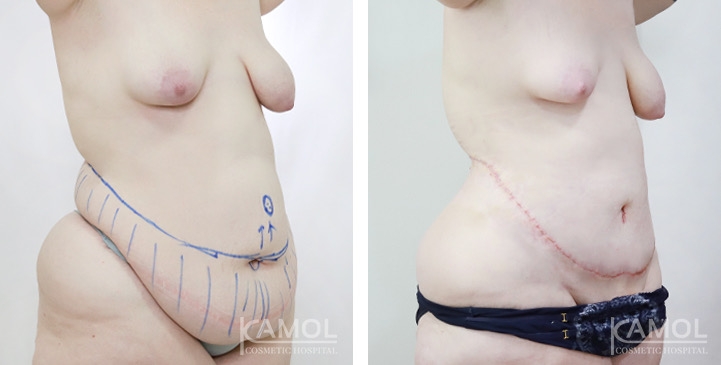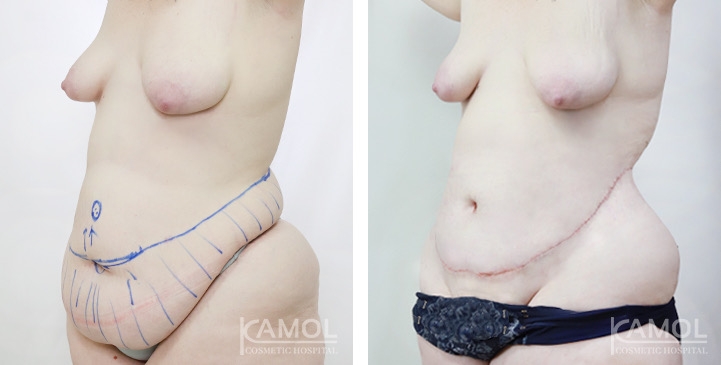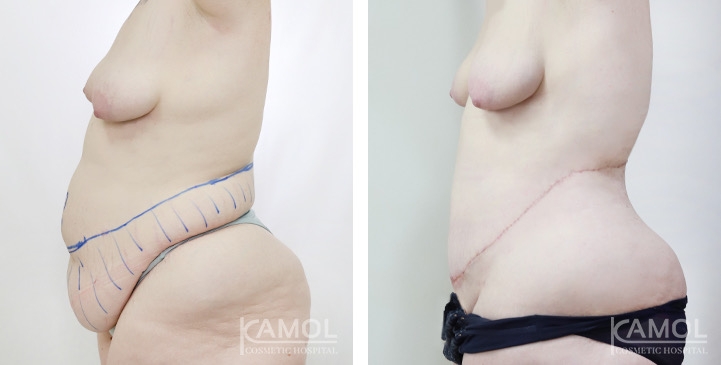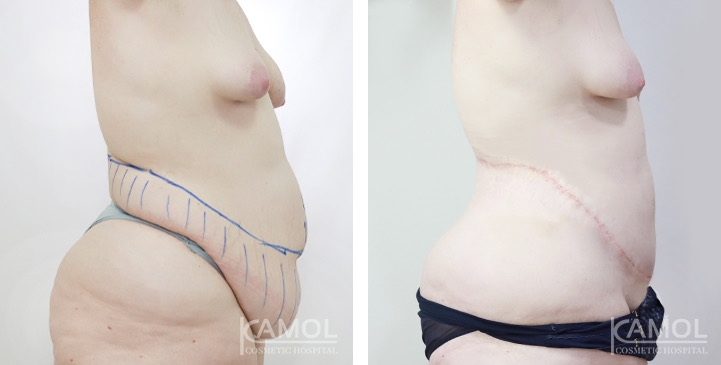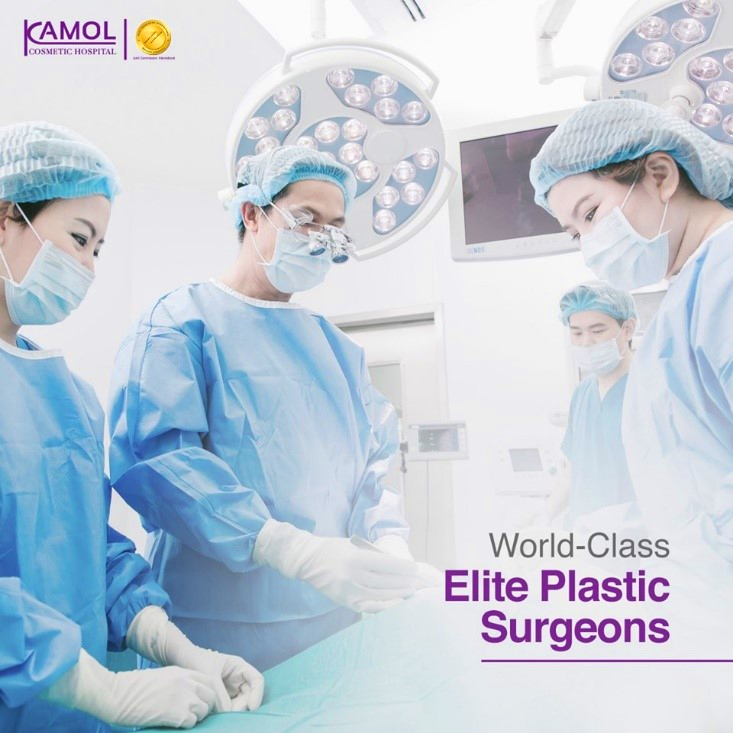泰国曼谷的腹部整形手术 / 腹部拉皮手术
腹部整形手术,也称为腹部拉皮手术,这种手术是透过去除多余的脂肪和皮肤,来紧实腹部肌肉,让腹部平坦。这种手术对产后妇女很有帮助,尤其是经历过多次怀孕的妇女,能帮助他们拥有理想身材。
手术在全身麻醉下进行,手术时间约为3-4小时,切口部位在比基尼线位置。术后,需要住院三晚,通常耻毛线处会根据多余脂肪和皮肤的量,从左侧延伸到右侧髋部留下疤痕。
我们提供两种类型的腹部整形手术 / 腹部拉皮手术:
1. 腹部整形手术 / 腹部拉皮手术(包括重新定位肚脐位置和修复松弛腹部肌肉)
这种手术需要全身麻醉,适合于有大量多余脂肪和皮肤或有生产妊娠纹的人。
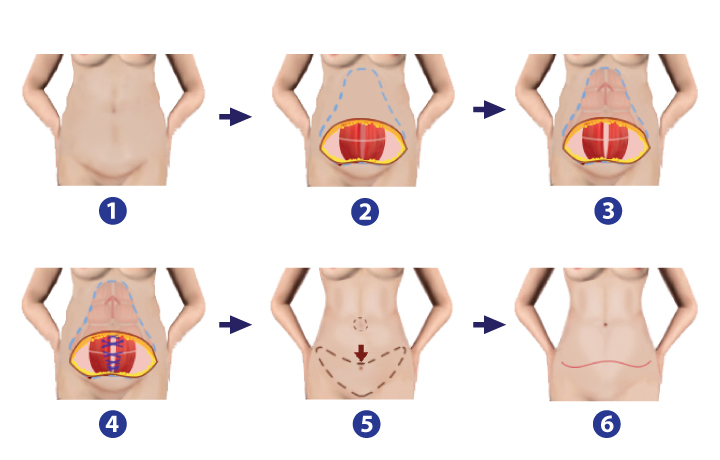
(Picture 1) 图1: 显示腹部整形手术 / 腹部拉皮手术(包括重新定位肚脐位置和修复松弛腹部肌肉) 步骤。
- 医生会确认肌肉的松弛程度来制作手术计画,如图1所示。
- 医生在比基尼线标记切口位置,然后从皮肤到肌肉层切开伤口,如图2所示。
- 医生将耻骨到乳下区域,皮肤层和肌肉层之间的纤维组织分离后,看到松弛的肌肉。
- 医生从乳下到耻骨区域修复松弛的腹部肌肉,紧实腹部肌肉,如图4所示。
- 将皮肤和脂肪层向下拉,去除从肚脐原位置到耻骨的多余部分。然后医生使用可吸收缝线缝合脂肪层,并小心地制作和修复新的肚脐,以防止产生疤痕,如图5所示。
- 医生切除耻骨部位的多余皮肤并缝合。
**手术时间约为3-4小时
2. 迷你腹部脂肪切除术
这种手术旨在消除皮肤扩张纹,适合于有中度脂肪过多但有肥胖纹的人。这种手术在局部或全身麻醉下进行,患者可以不用住院。

(Picture 2) 图2:显示迷你腹部脂肪切除术的步骤
- 医生会确认肌肉的松弛程度来制作手术计画,如图1所示。
- 医生在耻骨部位切开,从耻骨到脐下区域的皮肤层和肌肉层之间的纤维组织分离。
- 医生将皮肤和脂肪层向下拉,切除耻骨区域的多余皮肤并缝合。
如何准备腹部整形手术 / 腹部拉皮手术:
- 与外科医生讨论您的目标
- 进行体检、检验或医学评估
- 开始服用某些药物或调整您目前的药物
- 手术前后两周停止吸烟
- 避免服用阿司匹林、抗炎药物和草药补品,因为这些药物可能会增加出血风险
腹部整形手术 / 腹部拉皮手术步骤:
- 麻醉步骤:施作全身麻醉。
- 外科医生先在比基尼线标记切口位置后切开;如果患者需要重新定位肚脐位置和修复松弛的肌肉,则需要切开乳下区域(胸下区域)的腹肌上方组织,然后修复肌肉以在腹部中线处收紧。将皮肤向下拉并切除多余部分。如果患者需要进行迷你腹部拉皮手术,外科医生将打开切口并切除多余的皮肤。
- 用缝线闭合切口
腹部拉皮手术的术后护理:
- 手术后的2-3天内,患者必须每天穿着全长压力衣,以收紧肌肉和减少肿胀。手术后一个月,可以在晚上继续穿着压力衣以支撑肌肉。
- 手术后六天拆除缝线。
- 手术后约两个月,患者可以开始运动。
- 手术后三到四个月,肿胀会减少,伤口会愈合。
术后护理的重要提醒
- 手术后2-3天内请勿洗澡。遵照医生的建议包扎伤口。
- 在手术后的第一个月,应全天穿着压力衣。手术后一个月,患者应继续穿着压力衣以支撑肌肉防止伤口撕裂。
- 可能会有瘀青,但应该会在2-3周消失。如果有疼痛、肿胀或发红,请立即就医。
腹部拉皮手术的风险和常见并发症
- 出血
- 感染
- 液体积聚(浆液肿)
- 伤口愈合不良
- 皮肤受损
- 发麻
- 皮肤变色和长时间肿胀
- 疤痕
- 麻醉风险
- 皮肤再次松弛
- 脂肪坏死
- 深静脉血栓形成、心脏和肺部并发症
- 形状不对称
- 持续疼痛
腹部拉皮手术的恢复
腹部整形手术 / 腹部拉皮手术的恢复情况会因手术技术不同而异。手术后的几天内会留置引流管。引流管还在伤口的期间,您需要服用抗生素和抗凝血药物。您需要穿着腹部弹力带大约六周,这有助于避免液体积聚和支撑腹部。迷你腹部整形手术/腹部拉皮手术通常恢复期较短。您需要避免剧烈活动至少六周,在手术后2-6周就可以重返工作。
认识腹部整形手术 / 腹部拉皮手术
腹部除皱手术后如何预防和治疗疤痕?
在这篇文章中,我们将讨论预防腹部除皱疤痕的方法以及如果出现疤痕如何治疗。
妈妈整形
妈妈整形是一种个性化的美容手术组合,旨在帮助……
迷你腹部整形术与全腹部整形术
我们将探讨两者之间的主要区别,以帮助您做出明智的决定......
如何避免和治疗腹部拉皮手术后产生的疤痕
Reviews for Tummy Tuck
How long does it take for Tummy Tuck scars to go away?
The recovery time for a tummy tuck can vary depending on the individual and the extent of the surgery. Typically, the initial healing process can take several weeks. Generally, it can take several months for the incision lines to fully heal and for the scars to fade. However, the final appearance of the wounds can take up to a year or more. Additionally, after the surgery, it's important to follow the care instructions provided by your surgeon to ensure proper healing and to minimize the visibility of scars.
What are the steps to follow to treat Tummy Tuck scars?
The best way to treat tummy tuck scars is to follow the care instructions provided by your surgeon. Here are a few general steps that may be recommended:
- Keep the incision clean and dry: Your surgeon will give instructions on how to care for it, which may involve cleaning it with an antiseptic solution and keeping it covered with a bandage for the first few days.
- Avoid strenuous activities: You'll need to avoid strenuous activities that can cause strain on the abdominal area, such as heavy lifting or intense exercise, for several weeks after surgery.
- Wear compression garments: Your surgeon may recommend wearing a compression garment or elastic bandage to help support the abdominal area and reduce swelling.
- Massage the scars: After the incision has healed, your surgeon may recommend that you massage the wounds to help soften and flatten them.
- Avoid sun exposure: It is important to protect scars from the sun to prevent darkening or hyperpigmentation
- Use topical treatments: Your surgeon may recommend using topical treatments such as silicone gel or scar cream to help improve the appearance of the scars.
It's important to note that scarring is a natural part of the healing process, and not all scars can be completely eliminated. However, following these steps can help minimize the scars' visibility and promote healing.
How can Tummy Tuck scars be prevented, and how can they be controlled?
While it is impossible to completely prevent scars from forming after a tummy tuck, you can take steps to minimize their appearance and help them heal well.
- Choose a qualified surgeon: Selecting a skilled and experienced plastic surgeon can help minimize the risk of complications and ensure that the incision is made in a way that minimizes scarring.
- Follow post-operative instructions: Following your surgeon's post-operative instructions carefully, such as keeping the incision clean and dry, avoiding strenuous activities, and wearing compression garments as advised, can help to minimize the risk of complications and promote healing.
- Avoid sun exposure: It is important to protect the scars from the sun to prevent darkening or hyperpigmentation.
- Massage the scars: After the incision has healed, your surgeon may recommend that you massage the wounds to help soften and flatten them.
- Use topical treatments: Your surgeon may recommend using topical treatments such as silicone gel or scar cream to help improve the appearance of the scars.





